HYROX Sandbag Lunges Tutorial
HYROX Sandbag Lunges: Boost your performance with expert techniques. Master every lunge, improve strength, and achieve your fitness goals!



HYROX Sandbag Lunges: Boost your performance with expert techniques. Master every lunge, improve strength, and achieve your fitness goals!


HYROX races are an increasingly popular way to challenge your fitness or bond with a buddy by signing up for the Doubles category and splitting the fun… and sweat.
Whether you’re just looking into this form of fitness racing, preparing your first HYROX or studying up on the matter to help gym members, clients or close friends you have come to the right place.
The term “HYROX lunges” is used to refer to the seventh infamous functional station of the increasingly popular HYROX races. After running 7km and completing 6 other feats of strength and stamina with the previous functional movement stations you will reach the sandbag lunges.
Here at the seventh station you will be tasked to cover 100m distance while carrying a sandbag over your back.
FUN.
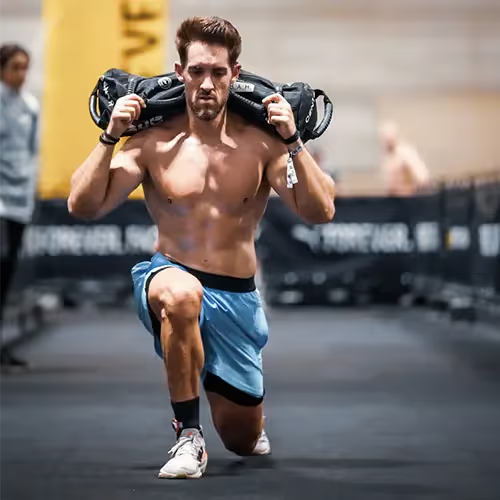
But this station is even more tricky than it seems as there are several movement standards you need to be aware of to not risk being penalized.
Let’s take a closer look at what these lunges look like, what to expect on race day and how to best prepare them.
Every individual approaching this station at a HYROX race will have to complete the 100m distance.
The only exception is for athletes competing in the Doubles division as they will be able to split the distance between each other.
You will be assigned a lane once reaching the seventh station. There, waiting for you, you’ll find three different sandbags at three set weights. Based on the division you compete in you will have to select the correct weight for yourself.
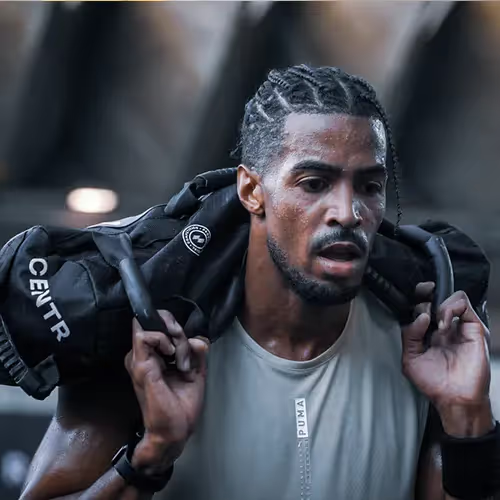
Women: 100m with a 10kg sandbag
Women Pro: 100m with a 20kg sandbag
Men: 100m with a 20kg sandbag
Men Pro: 100m with a 30kg sandbag
Mixed Doubles: 100m with a 20kg sandbag
Women Doubles: 100m with a 10kg sandbag
Men Doubles: 100m with a 20kg sandbag
Women Relay: 100m with a 10kg sandbag
Men Relay: 100m with a 20kg sandbag
Mixed Relay: Female members 100m with a 10kg sandbag / Male members 100m with a 20kg sandbag
Now, if you’re planning to compete in a HYROX race, let’s look at possibly the most crucial piece of information you need for these lunges. How penalties are given and therefore how to avoid them.
Avoiding penalties at this station is particularly important because:
So here’s what you need to know:
IF you place your sandbag down on the ground after you start lunging you will receive a 5m penalty. Meaning you will have to go back 5m and start lunging from there. Let us tell you: NOT worth it.
IF you place your sandbag on the ground for a second time after receiving your first penalty you WILL be DISQUALIFIED.
IF you are racing in the Doubles category, and you are NOT the working partner you MUST stand behind the partner who lunging (= stay in your lane). IF you are NOT, and especially if you end up blocking another duo who is completing the distance in another lane, you will receive a 10m penalty.
Also in the Doubles category when switching between partners you are NOT allowed to hand your sandbag to your partner from the front (= facing him).
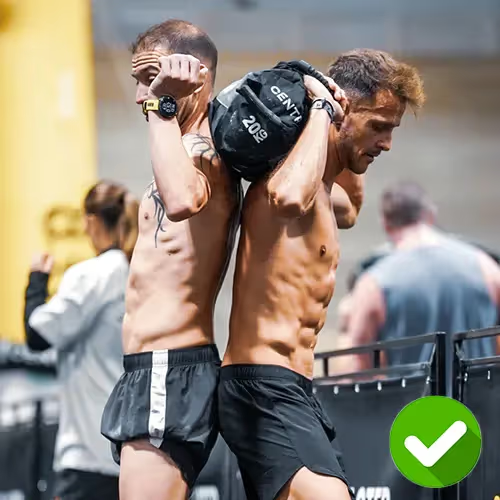
Lastly you should be highly aware of the expected standards as breaking any of them can lead once again to a 5m penalty.
These standards are:
There are 3 parts to the sandbag lunge when it comes to technique:
First off is “where to grab”.
You’ll see most sandbags have two sets of handles, the first on the actual body of the sandbag, quite close together. And the second set is right on the sides of the bag. The first provides much more stability but it requires sufficient mobility to get it in position. The latter is best for bigger framed athletes or if your shoulder mobility stops you from feeling comfortable with the more narrow handles.

There are 3 options available to you when it comes to getting that sandbag from the floor to your back.
If unclear we recommend watching THIS VIDEO:
" frameborder="0" allow="autoplay; fullscreen; picture-in-picture" allowfullscreen>
Funnily enough the most straightforward of the three parts.
We are looking for stability through the midfoot in the foot coming forward for the lunge. The leading knee should also bend at a minimum of 90 degrees when the back leg’s knee touches the ground.
A slight forward lean is good to keep momentum but when you come up you will want to stay as upright as possible. This is both to hit standard but also to make breathing easier (something you’ll be needing lots of after all the running you just did). And you want to ensure that, after you come down to have the knee of your trailing leg touch the ground, you extend both knee and hip at the same time. In other words we want to avoid the legs straightening before you move forward by extending your hips, something we often see in athletes lacking sufficient strength or stamina on the 100m.
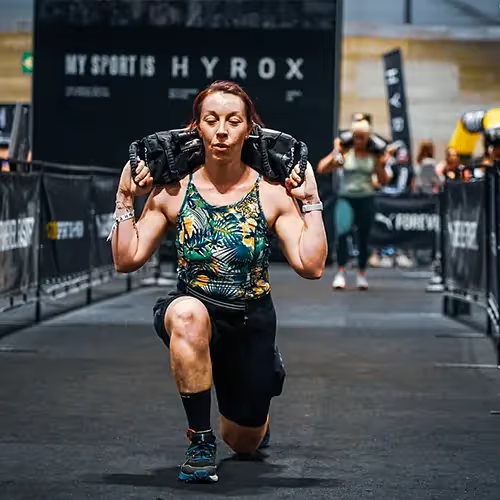
If you are struggling to hit standards with the assigned weight for your category we recommend jumping to the “DOs and DON’Ts of training HYROX Sandbag lunges” section of this article to learn how to get stronger and crush this station.
This phase is essentially the junction between one rep and the other. There are two options that you can choose between:
Strategy tips and common mistakes when performing HYROX Sandbag lunges
From a strategic standpoint there is not much in terms of tips that can be offered. The real deal breakers will be ensuring you have sufficient strength and lower body stamina + avoid penalties at all costs.
There are however two tips that can help you best strategize this station.
100m are a significant distance and after all the hard work you’ve gone through your legs will be feeling the burn. Plus you’ll have another km and MANY wallballs to complete after the lunges.
So what’s one to do?
Start straight away with practicing in training: have a plan in terms of how many steps you plan to take before coming to a stand to release muscle tension, give your stabilizers a break and let some extra blood reach your legs.
In training you can progressively increase that distance so that you know how long you can go between breaks on race day. And then stick to that plan.
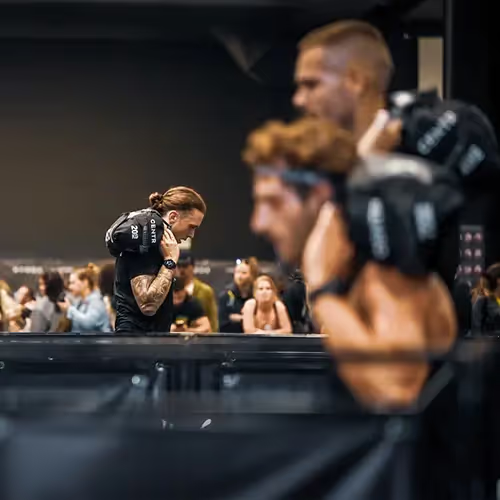
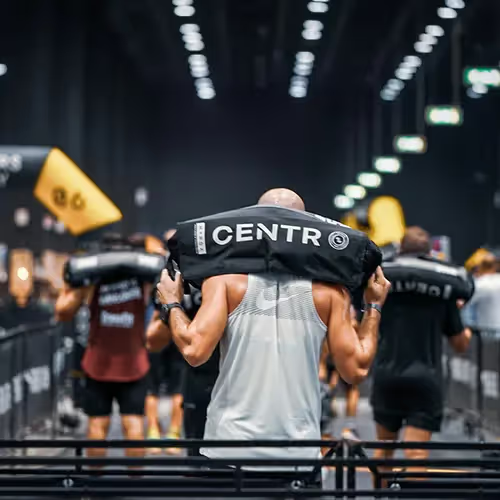
Ensure you have tested and trained your strength stamina, train lunges under fatigue, have a good strategy you will stick through at the start of the race to ensure you don’t burn out too soon.
When you are performing a good form sandbag lunge you are mainly using your posterior chain (think glutes and hamstrings) as well as your quads and adductors. To a minor extent your calves+shins, lower back and core will be involved to stabilize the movement.
Ensure you are strong enough to deal with the prescribed weight, if not DO NOT be scared of scaling down the weight until you are ready to go heavier. Make sure you spend proper time warming up your hips, knees and ankles and that your hamstrings are feeling warm anf good to go.
The average time to complete the sandbag walking lunge station in the Elitè category is 3 minutes. For the remaining categories the average time is 5 minutes. You should be aiming to fall within the minute from these averages, or below if you are looking to qualify for bigger races. However, at the end of the day other people’s paces and times DO NOT matter. Focus on your starting point and what your body allows you to do with the level of fitness reached by race day. It’s much more important to have a race plan and time that fits within your race goals to achieve success overall.
To wrap things up, sandbag lunges won’t make you or break your HYROX race score. However, they could make or break your race if you don’t follow standards and aren’t ready to lunge that bag till the end.
With smart training and preparation you can easily breeze through this station and set yourself up to finish strong on the last run and on the wall balls. But you need to be willing to put in the work in training.
Follow the exercise recommendations and tips in this article and you’ll find yourself crushing those sandbag lunges come race day.Found this helpful but still not sure what exactly you should be doing to prepare for your HYROX race? Getting on a good prep HYROX program is the first step.